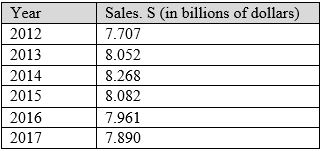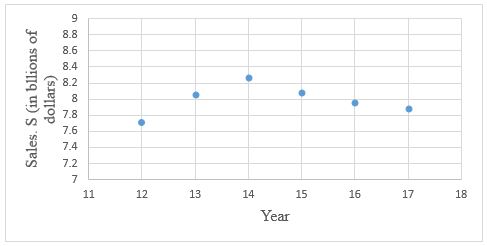
Concept explainers
a.
To graph: The given data in the form of a
a.
Explanation of Solution
Given data for graph:
Graph:
By using a graphing utility, a scatter plot is drawn below for given data.
Interpretation:
From the above graph, points
Also, the points
Conclusion:
The given scatter plot shows an approximately even rise and fall in the annual sales.
b.
To find: A linear model using regression utility.
b.
Explanation of Solution
Given data for graph:
Graph:
Interpretation:
The regression line shows the average movement of graph and has a positive slope thus indicating that the graph is growing upward despite the three downward movement in year 2015, 2016 and 2017.
c.
To write: A piecewise-defined model for the given data.
c.
Explanation of Solution
Given data for graph:
Given data can be represented as a piecewise-defined model by adding certain conditions for each line formed between two points.
In the graph for the year 2012 and 2013 the slope of the line is
Using slope point equation of line for the year 2012-2013 it can be written as
Similarly for the year 2013-2014 slope comes out to be

For the year 2014-2015, slope is
For the year 2015-2016, slope of line comes out to be

Finally, for the year 2016-2017, the slope is
d.
To find: The reason as to why a piecewise-defined model for the given data was possible.
d.
Explanation of Solution
Given data for graph:
Piecewise-defined function was possible for the given set of data as points could be plotted from the data. On connecting any two points we get a line and as every line has one single equation we were able to plot a piecewise −defined function.
Line drawn between two points gives a close estimate for points lying in between these points.
Conclusion:
Piecewise-defined model helps in studying a single phase/part of a graph.
Piecewise-model can be possible only if the graph cannot be satisfied by a single equation or condition.
Chapter 1 Solutions
EP PRECALC.GRAPHING APPR.-WEBASSIGN-1YR
 Calculus: Early TranscendentalsCalculusISBN:9781285741550Author:James StewartPublisher:Cengage Learning
Calculus: Early TranscendentalsCalculusISBN:9781285741550Author:James StewartPublisher:Cengage Learning Thomas' Calculus (14th Edition)CalculusISBN:9780134438986Author:Joel R. Hass, Christopher E. Heil, Maurice D. WeirPublisher:PEARSON
Thomas' Calculus (14th Edition)CalculusISBN:9780134438986Author:Joel R. Hass, Christopher E. Heil, Maurice D. WeirPublisher:PEARSON Calculus: Early Transcendentals (3rd Edition)CalculusISBN:9780134763644Author:William L. Briggs, Lyle Cochran, Bernard Gillett, Eric SchulzPublisher:PEARSON
Calculus: Early Transcendentals (3rd Edition)CalculusISBN:9780134763644Author:William L. Briggs, Lyle Cochran, Bernard Gillett, Eric SchulzPublisher:PEARSON Calculus: Early TranscendentalsCalculusISBN:9781319050740Author:Jon Rogawski, Colin Adams, Robert FranzosaPublisher:W. H. Freeman
Calculus: Early TranscendentalsCalculusISBN:9781319050740Author:Jon Rogawski, Colin Adams, Robert FranzosaPublisher:W. H. Freeman
 Calculus: Early Transcendental FunctionsCalculusISBN:9781337552516Author:Ron Larson, Bruce H. EdwardsPublisher:Cengage Learning
Calculus: Early Transcendental FunctionsCalculusISBN:9781337552516Author:Ron Larson, Bruce H. EdwardsPublisher:Cengage Learning





